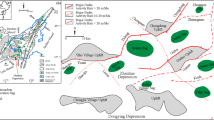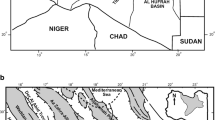Abstract
Eight oil samples from Lower Cretaceous Fahliyan reservoirs and 51 core and cutting samples from Upper Jurassic-Lower Cretaceous Garau Formation in Abadan Plain, Southern Iran, were analyzed using bulk property and molecular methods in order to identify their geochemical characteristics such as maturity and source depositional environment, as well as to correlate them to respective source rock(s). Rock-Eval pyrolysis and vitrinite reflectance measurements indicated that the Garau Formation, classified as a good-to-excellent source rock, the kerogen is mainly of Type II and the maturity is in peak oil generation. The crude oils of the Fahliyan reservoir are classified as light oil (API more than 35), non-biodegraded, saturate fraction, slight even/odd predominance, and front-end biased distribution in gas chromatogram. According to molecular and isotopic data, the oils were generated by a marine carbonate source rock which was deposited under the anoxic condition. Furthermore, all the studied samples reveal compositional similarity and hence can be assigned to one oil family, originating from a common source rock. Based on compositional similarities of biomarkers and isotope data in the studied crude oils and source rock, the Upper Jurassic-Lower Cretaceous Garau Formation can be regarded as the main source rock of the oils.







Similar content being viewed by others
REFERENCES
I. Abdollahi–Fard, A. Braathen, M. Mokhtari, and A. Alavi, “Interaction of the Zagros fold–thrust belt and Arabian–type, deep–seated folds in the Abadan plain and the Dezful embayment, SW Iran,” Petrol. Geosci. 12 (4), 347–362 (2006).
F. H. Abdullah and J. Connan, “Geochemical study of some Cretaceous rocks from Kuwait: comparison with oils from Cretaceous and Jurassic reservoirs,” Org. Geochem. 33, 125–148 (2002).
Q. Abeed, A. Alkhafaji, and R. Littke, “Source rock potential of the upper Jurassic–Lower Cretaceous succession in the southern Mesopotamian basin, Sothern Iraq,” J. Petrol. Geol. 34 (2), 117–134 (2011).
Q. Abeed, D. Leythaeuser, and R. Littke, “Geochemistry, origin and correlation of crude oils in Lower Cretaceous sedimentary sequences of the southern Mesopotamian Basin, southern Iraq,” Org Geochem. 46, 113–126 (2012).
Q. Abeed, R. Littke, F. Strozyk, and A. K. Uffmann, “The upper Jurassic–Cretaceous petroleum system of southern Iraq: a 3–D basin modeling study,” GeoArabia 18, 179–200 (2013).
B. Alizadeh, H. Saadati, M. Rashidi, and M. Kobraei, “Geochemical investigation of oils from Cretaceous to Eocene sedimentary sequences of the Abadan Plain, Southwest Iran,” Mar. Petrol. Geol., 73, 609–619 (2016).
A. A. M. Aqrawi, J. C. Goff, A. D. Horbury, and F. N. Sadooni, “The petroleum geology of Iraq”. (Scientific Press, Beaconsfield, 2010).
F. R. Aquino Neto, J. M. Trendel, A. Restle, J. Connan, and P. A. Albercht, “Occurence and formation of tricyclic and tetracyclic terpanes in sediments and petroleum,” Organic Geochemistry, Ed. by M. Bjoroy, P. Albrecht, and C. Cornfold (John Wiley & Sons, New York, 1981), pp. 659–676 (1983).
M. L. Bordenave and J. A. Hegre, “Current distribution of oil and gas fields in the Zagros Fold Belt of Iran and contiguous offshore as a result of the petroleum systems,” Geol. Soc. London, Spec. Publ. 330, 291–313 (2010).
C. J. Clayton, “Carbon isotope fractionation during natural gas generation from kerogen”. Mar. Petrol. Geol. 8, 232–240 (1991).
J. Espitalié, J. L. Laporte, M. Madec, F. Marquis, P. Leplat, and J. Paulet, “Méthoderapide de caractérisation des rochesmères, de leur potential pétrolieret de leur degree d’évolution,” Rev. l’InstitutFrançais du Pétrole 32, 23–45 (1977).
Galimov, E.M. “Isotope organic geochemistry,” Org. Geochem. 37, 1200–1262 (2006).
A. L. Herczeg and R. G. Fairbanks, “Anomalous carbon isotope fractionation between atmospheric CO2 and dissolved inorganic carbon induced by intense photosynthesis,” Geochim. Cosmochim. Acta 52, 895–899 (1987).
J. M. Hunt, Petroleum Geochemistry and Geology, 2nd ed., (W.H. Freeman and Company, New York, 1996).
W. B. Hughes, A. G. Holba, and L. I. P. Dzou, “The ratios of dibenzothiophene to phenanthrene and pristane to phytane as indicators of depositional environment and lithology of petroleum source rocks,” Org. Geochem. 17, 3581–3598 (1995).
G. A. James and J. G.Wynd, “Stratigraphic nomenclature of Iranian oil consortium agreement area,” AAPG Bull. 49 (12), 2182—2245 (1995).
S. Z. Jassim and H. C. Goff, “Geology of Iraq”. (Dolin, Prague and Moravian Museum, Brno, 2006).
J. M. Moldowan, W. K. Seifert, and E. J. Gallegos, “Relationship between petroleum composition and depositional environment”. AAPG Bull. 69, 1255–1268 (1985).
H. Motiei, An Introduction to Zagros Petroleum Reservoirs Evaluation, (For Geologists), 1rst ed. Vol. 2 (2010) [In Persian].
A. P. Murray, R. E. Summons, C. J. Boreham, and L. M. Dowling, “Biomarker and alkane isotope profiles for Tertiary oils: relationship to source rock depositional setting”. Org. Geochem. 22, 521–542 (1994).
M. Kobraei, Ph.D. Thesis (Tehran PolyTechnic University, Amir Kabir, 2016).
M. Kobraei, J. Sadouni, and A. R. Rabbani, “Organic geochemical characteristics of Jurassic petroleumsystem in Abadan Plain and north Dezful zones of the Zagros basin, southwest Iran”, J. Earth Syst. Sci. 128:50 (2019). https://doi.org/10.1007/s12040-019-1082-0
M. Kobraei, A. R. Rabbani, and F. Taati, “Lower Cretaceous Source rock Investigation in Western Zagros Basin–Southwest Iran,” J. Petrol. Explor. Prod. Technol. (2017). https://doi.org/10.1007/s13202-017-0362-y
K. E. Peters, and M. R. Cassa, “Applied source rock geochemistry,” The Petroleum System–From Source to Trap, Ed. by L. B. Magoon and W. G. Dow, AAPG Mem. 60, 93–120 (1994).
K. E. Peters, C. C. Walters, and J. M. Moldowan, “The Biomarker Guide. Biomarkers and Isotopes in Petroleum Exploration and Earth History”, (University of Cambridge Press, Cambridge, 2005), vol. 2, pp. 475–1155.
J. K. Pitman, D. Steinshouer, M. D. Lewan, “Petroleum generation and migration in the Mesopotamian Basin and Zagros Fold Belt of Iraq: results from a basin–modeling study”. GeoArabia 9 (4), 41–72 (2004).
M. Radke, P. Garrigues, and H. Willsch, “Methylated dicyclic and tricyclic aromatic hydrocarbons in crude oils from the Handil field, Indonesia”. Org. Geochem. 15, 17–34 (1990).
M. Radke, D. H. Welte, and H. Willsch, “Geochemical study on a well in the western Canada basin; relation of the aromatic distribution pattern to maturity of organic matter,” Geochim. Cosmochim. Acta 46, 1–10 (1982).
M. Radke, “Application of aromatic compounds as maturity indicators in source rocks and crude oils”. Mar. Petrol. Geol. 5, 224–236, (1985).
Y. Satarzadeh, J. W. Cosgrove, C. Vita Finzi, “The interplay of faulting and folding during the evolution of the Zagros deformation belt,” Forced Folds and Fractures, Ed. by J. W. Cosgrove and M. S. Ameen, Geol. Soc. Spec. Publ. London 169, 187–196 (2000).
P. R. Sharland, M. Archer, D. M. Casey, et al. “Arabian Plate Sequence Stratigraphy”. GeoArabia Spec. Publ., No. 2, (2001).
Z. Sofer, “Stable carbon isotope composition of crude oils; application to source depositional environment and petroleum alteration”. AAPG Bull. 68, 31–49 (1984).
J. Stocklin, “Possible ancient continental margins in Iran,” The Geology of Continental Margins, Ed. by C. A. Burk, & C. L. Drake (Springer, New York, 1974), pp. 873–887.
E. A. Subroto, R. Alexander, R. I. Kagi, “30-Norhopanes: their occurrence in sediments and crude oils,” Chem Geol. 93, p. 179–192, (1991).
G. H. Taylor, M. Teichmüller, A. Davis, C. F. K. Diessel, R. Littke, and P. Robert, Organic Petrology (GebrüderBorntraeger, Berlin—Stuttgart, 1998).
B. P. Tissot, and D. H. Welte, Petroleum Formation and Occurrence, 2nd Ed. (Springer, New York, 1984).
J. K. Volkmann, R. Alexander, R. I. Kagi, R. A. Noble, and G. W. Woodhouse, “A geochemical reconstruction of oil generation in Barrow sub-basin of Western Australia,” Geochim. Cosmochim. Acta 47, 2091–2106 (1983).
H. M. Weiss, A. Wilhelms, N. Mills, J. Scotchmer, P. B. Hall, K. Lind, and T. Brekke, NIGOGA – “The Norwegian Industry Guide to Organic Geochemical Analyses [online].” Edition 4.0 Norsk Hydro, Statoil, Geolab Nor, SINTEF Petroleum Research and the Norwegian Petroleum Directorate. Available from World Wide Web: <http://www.npd.no/engelsk/nigoga/default.htm> (cited 24.08.11) (2000).
A. Zeinalzadeh and A. Sajjadian, “Investigation of source rock zones in Darquain oilfield by petrophysical and Rock Eval data,” J. Sci. Tehran Univ. 35, 63–70 (2009) (In Persian).
A. Zeinalzadeh, R. Moussavi-Harami, A. Mahboubi, and V. A. Sajjadian, “Basin and petroleum system modeling of the Cretaceous and Jurassic source rock of the gas and oil reservoirs in Darquain field, south west Iran,” J. Nat. Gas Sci. Eng., 26, 419–426 (2015).
D. Zhang, D. Huang, and L. Jinchao, “Biodegraded sequences of Karamay oils and semi quantitative estimation of their biodegraded degrees in Junggar Basin, China,” Org. Geochem. 13, 295–302 (1988).
6. ACKNOWLEDGMENTS
The authors would like to thank the National Iranian Oil Company Exploration Directorate for providing samples, data, and financial support of geochemical analysis. We are also grateful to the Geochemistry Department of NIOCEXP and Department of Geology for helpful discussions and comments which improved the original manuscript.
Author information
Authors and Affiliations
Corresponding authors
Rights and permissions
About this article
Cite this article
Mehdi Kobraei, Rabbani, A. & Taati, F. Upper Jurassic-Lower Cretaceous Source-Rock Evaluation and Oil—Source Rock Correlation in the Abadan Plain, Southwest Iran. Geochem. Int. 57, 790–804 (2019). https://doi.org/10.1134/S0016702919070073
Received:
Revised:
Accepted:
Published:
Issue Date:
DOI: https://doi.org/10.1134/S0016702919070073




